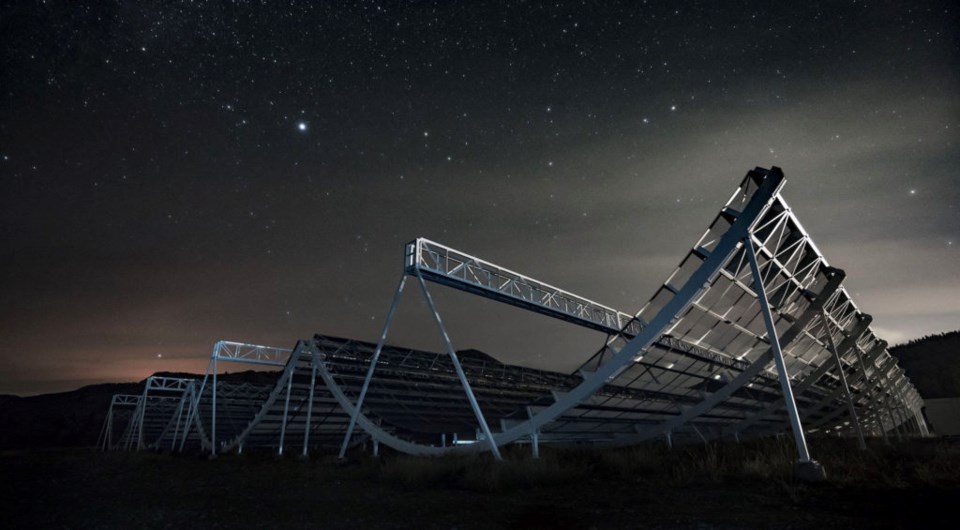Canadian and U.S. astronomers are heralding the detection of radio pulses from deep space they say could be used as something of an astrophysical clock.
“The frequency of the bursts, and how they change as the source moves away from Earth, could be used to measure the rate at which the universe is expanding,” explained Massachusetts Institute of Technology’s (MIT) Daniele Michilli, a post-doctoral researcher at Kavli Institute for Astrophysics and Space Research.
The astronomers are working with the Canadian Hydrogen Intensity Mapping Experiment (CHIME), which operates an interferometric radio telescope consisting of four large parabolic reflectors. It's located at B.C.’s Dominion Radio Astrophysical Observatory near Penticton.
What the researchers have detected is a signal classified as a fast radio burst (FRB) — an intensely strong burst of radio waves of unknown astrophysical origin, that typically lasts for a few milliseconds at most.
In December 2019, CHIME picked up a signal of a potential FRB, which immediately drew the attention of Michilli, who was scanning the incoming data.
“It was unusual,” Michilli said. “Not only was it very long, lasting about three seconds, but there were periodic peaks that were remarkably precise, emitting every fraction of a second — boom, boom, boom — like a heartbeat. This is the first time the signal itself is periodic.”
Those three seconds are about 1,000 times longer than the average FRB.
Within this window, the team detected bursts of radio waves that repeat every 0.2 seconds.
The signal’s source is in a distant galaxy, several billion light-years from Earth.
However, exactly what that source might be remains a mystery. Astronomers suspect it could come from either a radio pulsar or a magnetar, both types of neutron stars — extremely dense, rapidly spinning collapsed cores of giant stars.
“There are not many things in the universe that emit strictly periodic signals,” Michilli said. “Examples that we know of in our own galaxy are radio pulsars and magnetars, which rotate and produce a beamed emission similar to a lighthouse. And we think this new signal could be a magnetar or pulsar on steroids.”
While the information was published in the journal Nature on July 13, a catalogue of FRBs was presented by UBC an other researchers on June 9 at an American Astronomical Society meeting.
“This catalogue marks a significant turning point in the FRB field,” said Bradley Meyers, a UBC post-doctoral researcher in the Department of Physics and Astronomy and member of the CHIME collaboration.
“We’re now firmly in the regime where robust analyses can be used to investigate properties of FRBs as a population, rather than on an individual basis. There’s a huge amount of science that we can do with this catalogue, and I think a lot of it will be exploring ideas we haven’t even come up with yet.”
Okanagan telescope
The CHIME radio telescope was designed and built by scientists at UBC, McGill University, the University of Toronto, the Perimeter Institute for Theoretical Physics and the National Research Council of Canada.
Unlike traditional telescopes, CHIME has no moving parts. Rather, it uses more than 1,000 antennae to record information from all radio waves falling across its surface. It receives radio signals each day from half of the sky as the Earth rotates.
“Digital signal processing is what makes CHIME able to reconstruct and ‘look’ in thousands of directions simultaneously,” says Kiyoshi Masui, assistant professor of physics at MIT. “That’s what helps us detect FRBs a thousand times more often than a traditional telescope.”




